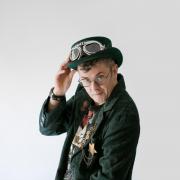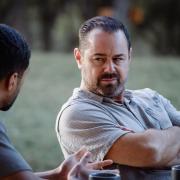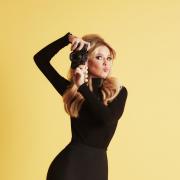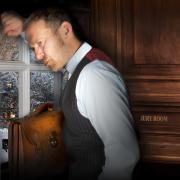Born in Leytonstone, Sir Alfred Hitchcock is still famously known as Hollywood’s ‘master of suspense’ 100 years after his first day on the job in the film industry | Words: Stephen Roberts

It’s a sunny Sunday afternoon. I’ve just washed my car and, almost as if they have been watching, it is immediately precision bombed by one of our feathered ‘friends’.
Somehow it all puts me in mind of Sir Alfred Hitchcock’s The Birds (1963), a horror film that depicted unexplained, violent bird attacks on humans.
Born at the tail-end of the Victorian era (on August 13, 1899), Hitchcock, who began as a junior technician in 1920, graduated to motion picture director by 1925, then film producer.
He’s still known today as the ‘master of suspense’ and there are any number of films from The 39 Steps (1935) to Psycho, a quarter of a century later, that have that undeniable ‘Hitchcock touch’.

Hitchcock was born in a flat above a shop at 517 High Road, Leytonstone, which was part of Essex in those days. It was a greengrocer’s shop, leased by his parents, William, a harsh disciplinarian, and Emma, who was overly protective by contrast.
Alfred was the youngest of three children born to this pair of half-Irish Roman Catholics, living on the outskirts of East London, and was raised as a strict Catholic.
In fact, it was the East End that the young Hitchcock would come to know, as the family moved to Limehouse when he was six (where they leased a pair of shops), with Alfred attending school for the first time when he was seven (in Poplar in 1907).
When Hitchcock was 11, the peripatetic family had moved again, to Stepney. His interest in films appears to have begun around 1915, by which time he was in his mid-teens, although his early ambition had been to be an engineer.
A talented artist and with an interest in photography, Hitchcock got his foot through the movie door as a set drawer (1920) and title-card designer (silent movies needed these), quickly moving on to art direction, production design, editing, directing (assistant) and even writing.
In a plot twist worthy of one his movies, Hitchcock got his break when the director of Always Tell Your Wife (1923) fell ill, with Hitchcock drafted in as a replacement director.
After that, he began to direct in his own right, just five years after joining the industry, with his first trademark production being The Lodger: A Story of the London Fog (1927), which was loosely based on the reign of terror of Jack the Ripper, something that was very much in living memory at the time (and much recalled at the time of Hitchcock’s youth). It was a silent movie.
Later that year Hitchcock married Alma Reville, a cutter/editor who he’d already collaborated with on films. They’d have one child, Patricia (born in 1928).

Hitchcock was in on the cusp of ‘talkies’ and his debut talking picture was Blackmail (1929), which included a chase sequence through the British Museum and was the first British film to have synchronised sound (post-dubbing of an original silent version).
Hitchcock’s fame really arrived with his first international success, The Man Who Knew Too Much (1934), which concludes with a famous Royal Albert Hall finale.
This was followed by the romantic thriller The 39 Steps (1935), and adaptions of a pair of Daphne de Maurier novels, namely Jamaica Inn (1939) and Rebecca (1940), for which Hitchcock received his first Oscar nomination (Best Director).
Hitchcock had truly arrived and his name became so well known, that films would be marketed as such: it was his name that would sell a movie.

The thriller Strangers on a Train (1951) explored the consequences of a chance meeting on a train between a man trapped in an unhappy marriage and a psychopath who wanted to be rid of his father and a ‘bargain’ that they commit murder on one another’s behalf so that they cannot be connected to the crimes.
Dial M for Murder (1954) was shot in 3-D, which was a bit of a craze around that time, while To Catch a Thief (1955) featured one of Hitchcock’s favourite actresses, Grace Kelly, but not for much longer.
The film was shot on the French Riviera, where the actress met Prince Rainier of Monaco. She would soon be lost to the movies, and Hitchcock, once and for all. It is said that he regretted making that particular film for that reason.
Arguably though, his real fame took off from 1955 with Alfred Hitchcock Presents broadcast in homes week after week, demonstrating the rising power of TV.

As Alfred Hitchcock Presents (until 1962) and then The Alfred Hitchcock Hour (until 1965), the medium introduced him to a far wider audience and really established him as the world’s most famous director.
He directed 20 of the episodes himself, while carefully vetting what else was produced and by whom.
When Hitchcock re-made his own The Man Who Knew Too Much (1956), he went big budget, but also made a star of Doris Day, who sang Que Sera, Sera.
Vertigo (1958) is considered by many to have been Hitchcock’s finest film, in which a retired cop (James Stewart) is asked to shadow a wealthy acquaintance’s wife (Kim Novak).
Hitchcock went on to push the boundaries in the 1960s, beginning with Psycho (1960) and its infamous shower scene and subsequent lunacy of Norman Bates. Psycho gave Hitchcock the last of his five Best Director Oscar nominations.
The movie mogul also appreciated that a lot of his success was down to Alma, who’d suffered a debilitating stroke in the early-70s. He praised her in equal measure for her editing, scriptwriting, mothering and cooking.
If she was his inspiration, then he was inspired: the greatest of directors, the most adroit, the most keenly admired, a great filmmaker and storyteller.
Always formally dressed on set and with a trademark dry wit, dark gallows humour and slow speech, Hitchcock inspired his own adjective ‘Hitchcockian’ to describe a suspense thriller.

His humour was macabre, which was evident in both his films and the way he went about his work. If you were one of his actors and confessed to suffering from arachnophobia, you’d be unlikely to attract any sympathy, although a box full of spiders, possibly.
His films also tell us that he possessed a rather bleak view of the human condition, as his films were not often happy yarns.
Look out for Hitchcock cameos in his films. He appeared in all but 18 of the 56 films he directed.
Also, watch out for his signature moves: a lady’s hairstyle in close-up; bathrooms; the ‘wrong man’ or lost or assumed identity; alternation between different shots to create suspense; the famous profile sketch; the use of shadow; seemingly insignificant objects that help drive the plot; a lack of location shots (Hitchcock preferred the studio) and encouraging the audience to empathise with a villain’s plight.

And then there was The Birds (1963), which I think of every time I wash my car.
Although Hitchcock was nominated for five Best Director Oscars, he never won one of the famed statuettes (surely one of the Academy’s most notable injustices).
His moment came in 1968, however, when he was awarded the honorary Irving G. Thalberg Memorial Award, which goes to ‘creative producers, whose bodies of work reflect a consistently high quality of motion picture production’.
The trophy may not be the familiar Oscar, but it’s regarded as an honorary one. Hitchcock gave the shortest acceptance speech ever, just two words, ‘Thank you’.
‘Hitch’, as he was known, was knighted in 1979 and died 40 years ago, in the States, on April 29, 1980, aged 80, his last years having been blighted by ill health.
I have just two words to say to him. Thank you.
Hitchcock trivia
- Although nominated five times, Alfred Hitchcock never won a Best Director Oscar.
- His own daughter appeared in three of his films, including Psycho.
- He won a lifetime achievement award (1979), joking that he would die soon. He did (1980).
- Hitchcock was a supporter of West Ham United FC.
- Alfred Hitchcock’s voice is used for the Jaws ride at Universal Studios.
- Hitchcock had two phobias, the police and the humble egg.
- He was the first celebrity visitor to Coronation Street in 1964, drinking at the Rovers Return.
- Alma Reville was one day younger than Hitchcock (August 14 v August 13, 1899).
- He was a great fan of one word titles, eg Psycho and Vertigo.
- Hitchcock had hoped to make a movie about the sinking of RMS Titanic, but never did.



























